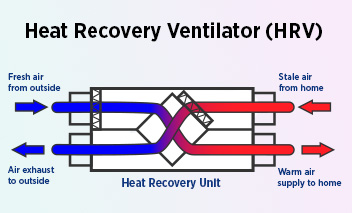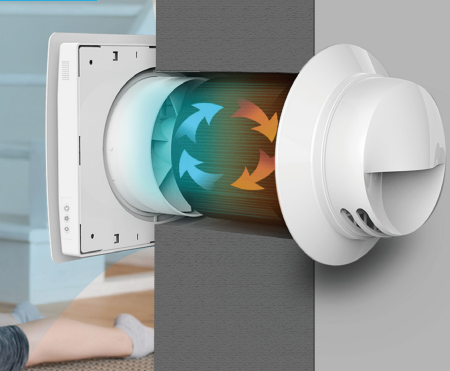Introducing the Secret Conveniences and Uses of Heat Recovery Ventilation in Lasting Style
Heat Recovery Ventilation (HRV) systems play an important function in sustainable style. They assist in a continual exchange of stagnant indoor air with fresh exterior air, greatly enhancing indoor air high quality. Moreover, HRVs add to energy effectiveness by reclaiming warm from exhausted air, which can reduce utility costs. Recognizing the multifaceted advantages and applications of HRVs exposes their significance in contemporary architecture. What various other advantages do these systems supply in the search of sustainability?
Comprehending Heat Recovery Ventilation Equipments
Heat recovery ventilation (HRV) systems are developed to improve indoor air top quality while reducing energy loss. These systems use a mechanical air flow strategy to exchange stagnant interior air with fresh exterior air, making sure a continual supply of clean air. By recording warmth from the exhaust air, HRVs prerequisite inbound air, lowering the need on heating and cooling down systems. This process not only improves thermal convenience yet also contributes to power effectiveness in residential and business structures. Furthermore, HRV systems assist regulate moisture levels and minimize interior toxins, advertising a healthier living atmosphere. Their calculated implementation is necessary for achieving lasting design objectives, as they supply an equilibrium between energy preservation and passenger wellness.
Exactly How HRV Systems Work
While several may be familiar with air flow systems, recognizing exactly how warmth recovery air flow (HRV) systems operate is vital for appreciating their advantages. HRV systems operate by exchanging stagnant indoor air with fresh outside air while transferring warmth in between both streams. This process occurs in a warmth exchanger, where warm from the outward bound air heats the inbound air throughout colder months, minimizing energy loss. Alternatively, in warmer months, the system can cool down inbound air using the cooler outward bound air. HRVs are equipped with fans to assist in airflow and filters to eliminate particulates, making certain a continuous, balanced ventilation procedure. This innovative design not only improves energy effectiveness yet likewise adds to preserving a comfy interior atmosphere.
Enhancing Indoor Air Quality
Interior air quality can substantially influence health and wellness and well-being, making effective air flow essential in contemporary homes. Heat Recovery Ventilation (HRV) systems play a vital role in maintaining indoor air quality by continually exchanging stagnant interior air with fresh exterior air. This process not just reduces air-borne contaminants however also lessens humidity levels, which can bring about mold and mildew development and respiratory system issues. HRV systems filter incoming air, getting rid of allergens and particulates, consequently offering a healthier living environment. Furthermore, these systems aid get rid of odors and volatile organic compounds (VOCs) generally found in home items. By ensuring a consistent flow of tidy air, HRV systems contribute to an overall improved indoor environment, advertising comfort and well-being for occupants.
Energy Effectiveness and Cost Financial Savings
Energy efficiency sticks out as a substantial advantage of Heat Recovery Ventilation (HRV) systems. By capturing and reusing the warm from tired interior air, HRVs minimize the power required for home heating incoming fresh air, bring about lowered energy consumption. This efficiency translates right into reduced energy bills, providing considerable price financial savings for homeowners and businesses alike. Furthermore, HRV systems usually certify for power efficiency incentives and rebates, even more boosting their economic appeal. In time, the preliminary financial investment in HRV modern technology can cause a beneficial return on investment via reduced power costs. Consequently, the assimilation of HRV systems not just promotes sustainable style yet likewise provides a practical remedy for accomplishing long-term energy savings and economic advantages.
Ecological Benefits of HRV

A wide range of ecological advantages arises from the application of Heat Recovery Ventilation (HRV) systems. By successfully transferring warmth from exhaust air to incoming fresh air, HRVs substantially lower the energy required for home heating and cooling down spaces. This energy effectiveness translates to decrease greenhouse gas discharges, adding to a reduction in the total carbon impact of buildings. Additionally, HRV systems boost interior air high quality by continuously distributing fresh air, thus reducing the concentration of indoor toxins and allergens. Moreover, the reduction in energy intake help in conserving all-natural resources, making HRVs an important component of lasting design. Generally, the ecological benefits of HRVs play an essential function in promoting a healthier planet and fostering eco-friendly structure practices.
Versatile Applications in Modern Design
Heat recovery ventilation (HRV) systems are significantly being incorporated into both household and commercial building projects. In property setups, HRVs improve indoor air top quality while making best use of energy efficiency. On the other hand, in industrial areas, these systems maximize air flow approaches, demonstrating their adaptability in modern-day building applications.
Residential Projects Assimilation
While modern architecture increasingly highlights sustainability, the integration of warm recovery ventilation systems in property jobs has actually emerged as a sensible remedy for boosting interior air high quality and energy effectiveness. These systems effectively move heat from exhaust air to incoming fresh air, decreasing index power loss and minimizing heating or cooling down needs. In new builds and retrofits alike, heat recuperation ventilation can be flawlessly incorporated, offering homeowners with a healthier living setting while decreasing utility expenses. Furthermore, with enhancing recognition of ecological impacts, even more engineers and contractors are recognizing the long-lasting benefits of these systems. As a result, heat recovery air flow has come to be an important part of lasting residential design, showcasing convenience and dedication to environment-friendly methods.
Commercial Spaces Optimization
As contemporary commercial rooms progress to satisfy the demands of sustainability and performance, the execution of warm healing ventilation systems arises as a vital strategy for maximizing indoor settings. These systems assist in the exchange of stale interior air with fresh outdoor air while recovering heat, considerably decreasing energy intake. This not only boosts convenience for occupants yet also aids in lowering operational expenses. Versatile applications can be observed in offices, retail spaces, and schools, where air top quality and temperature control are extremely important. Additionally, incorporating heat recuperation ventilation straightens with environment-friendly structure certifications, further promoting ecological responsibility. Inevitably, adopting such systems in industrial style not just contributes to sustainability goals yet additionally fosters much healthier, extra productive spaces for individuals.
Incorporating HRV Into Sustainable Style Practices
Integrating warmth recuperation air flow (HRV) systems right into sustainable design practices provides substantial benefits in power performance and indoor air high quality. By making use of HRV, designers can develop affordable remedies that not just minimize energy intake but also boost the overall convenience of interior settings. This placement with sustainability goals positions HRV as great site an important element in modern building methods.
Energy Performance Improvement
By including warmth recuperation ventilation (HRV) systems into sustainable style practices, engineers and building contractors can considerably boost power performance in contemporary buildings. HRV systems function by recording warmth from outbound stagnant air and transferring it to inbound fresh air, reducing the energy needed for home heating or cooling indoor spaces. This procedure not only minimizes reliance on typical heating and cooling systems however additionally reduces overall energy intake. Furthermore, HRV systems can aid maintain a consistent interior temperature level, decreasing peak power demands. By integrating these systems, buildings can accomplish significant reductions in utility prices and carbon impacts, straightening with sustainability objectives. Ultimately, HRV modern technology represents a practical solution for improving energy performance in the constructed atmosphere, promoting even more liable resource use.
Indoor Air Quality Enhancement
Exactly how can warm recovery ventilation (HRV) systems add to exceptional indoor More Help air top quality in modern-day buildings? HRV systems successfully exchange stagnant interior air with fresh outside air while recuperating warmth power, minimizing temperature level variations. This process decreases the concentration of indoor pollutants, such as volatile organic substances (VOCs), allergens, and moisture, which can weaken air quality and effect resident wellness. By maintaining perfect moisture levels and guaranteeing a continuous supply of tidy air, HRVs help produce a much healthier interior environment. Furthermore, these systems can be incorporated into lasting style techniques, advertising energy efficiency together with improved air high quality. HRV Heat Recovery Ventilation. Consequently, HRV modern technology plays a crucial role in advancing general resident convenience and health in modern architectural designs
Cost-Effective Design Solutions

Often Asked Inquiries
What Maintenance Is Required for Heat Recovery Ventilation Solutions?

Upkeep for warm recovery air flow systems commonly includes regular filter replacements, cleansing of heat exchangers, assessment of followers and air ducts, and ensuring proper drainage. These jobs assist maintain effectiveness and extend the system's life expectancy over time.
Can HRV Systems Be Set Up in Existing Structures?
Heat recovery ventilation systems can certainly be installed in existing structures. HRV Heat Recovery Ventilation. Retrofitting requires cautious planning and analysis of the structure's layout, making certain compatibility with existing systems while making best use of power performance and interior air quality
Just How Do HRV Equipment Effect Sound Levels Indoors?
HRV systems can influence indoor noise levels by presenting noise from external sources via air flow. High-quality installments frequently include sound-dampening functions, minimizing noise effect while supplying effective air exchange and keeping comfort inside.
Exist Any Disadvantages to Using HRV Equipments?
The disadvantages of using HRV systems include prospective high first costs, upkeep challenges, and the opportunity of minimized interior air top quality if filters are sporadically transformed, which could cause problems with moisture degrees.
Exactly how Do I Choose the Right HRV System for My Needs?
Selecting the appropriate warm healing ventilation system involves reviewing certain needs, such as constructing size, climate, and energy performance goals. In addition, reviewing system attributes, installment needs, and maintenance factors to consider is necessary for peak efficiency and complete satisfaction.